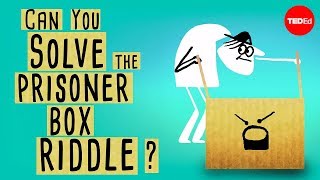(单词翻译:单击)
Your favorite band is great at playing music, but not so great at being organized.
你最喜爱的乐队演奏的时候很出色,但并不怎么擅长组织与编排工作。
They keep misplacing their instruments on tour, and it's driving their manager mad.
他们老是在巡演的时候放错乐器,这让他们的经理十分恼火。
On the day of the big concert, the band wakes up to find themselves tied up in a windowless, soundproof practice room.
就在一场大型音乐会的当天,这个乐队醒来发现他们被绑在一个没有窗户并且隔音的练习室。
Their manager explains what's happening.
他们的经理解释了这是怎么回事。
Outside, there are ten large boxes.
在外面,一共有十个大盒子。
Each contains one of your instruments, but don't be fooled by the pictures -- they've been randomly placed.
每一个装着一件你们的乐器,但别被上面的图片迷惑了,他们都是随机放置的。
I'm going to let you out one at a time.
每次我会让你们其中的一人出去。
While you're outside, you can look inside any five boxes before security takes you back to the tour bus.
这时候你们可以查看任意五个盒子,然后保安会把你们带回巴士。
You can't touch the instruments or in any way communicate what you find to the others.
你们不能触碰乐器,也不能以任何形式同他人交流你发现了什么。
No marking the boxes, shouting, nothing.
不能在盒子上做记号,不能喊叫,什么都不能。
If each one of you can find your own instrument, then you can play tonight.
如果你们每人都能找对你们的乐器,你们今晚就能演出。
Otherwise, the label is dropping you.
否则演出将被取消。
You have three minutes to think about it before we start.
你们有三分钟的思考时间,然后我们就开始。
The band is in despair.
整个乐团都十分绝望。
After all, each musician only has a 50%chance of finding their instrument by picking five random boxes.
毕竟,如果只是随机看五个盒子,每个人只有50%的机会找到自己的乐器。
And the chances that all ten will succeed are even lower -- just 1 in 1024.
十个人都找对的几率就更低了,只有1/1024。
But suddenly, the drummer comes up with a valid strategy that has a better than 35% chance of working.
但是突然,鼓手想出了一个有效的策略,有大于35%的机率能成功。
Can you figure out what it was?
你能想出来这个策略是什么吗?
Pause the video on the next screen if you want to figure it out for yourself!
如果你想自行思考该策略的话,请在下一画面按暂停!
Here's what the drummer said: Everyone first open the box with the picture of your instrument.
鼓手是这么说的:每人首先打开有自己乐器图片的盒子。
If your instrument is inside, you're done.
如果里面就是你们的乐器,那就完成了。
Otherwise, look at whatever's in there, and then open the box with that picture on it.
如果不是,就看看里面是什么,再打开有该乐器图片的盒子。
Keep going that way until you find your instrument.
以此类推,直到找到你们各自的乐器。
The bandmates are skeptical, but amazingly enough, they all find what they need.
其他乐队成员们都表示怀疑,但令人惊奇的是,他们最终都找到了各自的乐器。
And a few hours later, they're playing to thousands of adoring fans.
几小时后,他们为成千上万喜爱他们的粉丝带来了精彩演出。
So why did the drummer's strategy work?
为什么鼓手的策略能得以成功呢?

Each musician follows a linked sequence
每个乐手的选择都是一个相联结的序列,
that starts with the box whose outside matches their instrument and ends with the box actually containing it.
该序列始于有各自乐器图片的盒子,终于实际装有各自乐器的盒子。
Note that if they kept going, that would lead them back to the start, so this is a loop.
值得注意的是,继续以此类推的话,他们的选择将回到最初的盒子,所以这其实是一个循环。
For example, if the boxes are arranged like so, the singer would open the first box to find the drums,
比如说,如果盒子是按此法摆放,歌手会先打开第一个盒子找到鼓,
go to the eighth box to find the bass, and find her microphone in the third box, which would point back to the first.
然后打开第八个盒子找到贝斯,然后打开第三个盒子找到麦克风,这也将指引他回到第一个盒子。
This works much better than random guessing because by starting with the box with the picture of their instrument,
这样比随机猜五个盒子有效多了,因为从有他们各自乐器图片的盒子开始找,
each musician restricts their search to the loop that contains their instrument,
每位乐手都将选择限制在包含他们各自乐器的循环里,
and there are decent odds, about 35%, that all of the loops will be of length five or less.
并且有不错的机率,大概有35%,所有这样的循环只要五步或者更少。
How do we calculate those odds?
我们如何算出这个机率的呢?
For the sake of simplicity, we'll demonstrate with a simplified case,
为了简便,我们举一个简化的例子,
four instruments and no more than two guesses allowed for each musician.
只有四种乐器,每个乐手最多只能打开两个盒子。
Let's start by finding the odds of failure,
我们先来看看失败的概率,
the chance that someone will need to open three or four boxes before they find their instrument.
也就是说需要打开三个或者四个盒子才能猜对自己的乐器的概率。
There are six distinct four-box loops.
总共有六种不同的四个步骤循环。
One fun way to count them is to make a square, put an instrument at each corner, and draw the diagonals.
计算这个的一个有趣的办法是去画一个方形,把四个乐器分别摆到四个角,然后画出对角线。
See how many unique loops you can find,
看看你究竟能找出多少独特的循环,
and keep in mind that these two are considered the same, they just start at different points.
注意这两种循环其实是同一种,只是始于不同的起点而已。
These two, however, are different.
然而,这两种就不相同啦。
We can visualize the eight distinct three-box loops using triangles.
我们用三角形就能观察到八种不同的三个步骤的循环。
You'll find four possible triangles depending on which instrument you leave out, and two distinct paths on each.
总共有四种三角形,取决于哪一种乐器不含在其中,而每种三角形有两种不同的路径。
So of the 24 possible combinations of boxes, there are 14 that lead to failure, and ten that result in success.
所以在总共24种盒子的排列组合中,有14种会失败,还有10种会成功。
That computational strategy works for any even number of musicians,
这种计算方法适用于任何有偶数个乐手的情况,
but if you want a shortcut, it generalizes to a handy equation.
但是如果你想要一个简便办法,可以概括成一个方便的方程式。
Plug in ten musicians, and we get odds of about 35%.
代入10位乐手,得出约35%的概率。
What if there were 1,000 musicians? 1,000,000?
如果有1000位乐手呢?1000000位呢?
As n increases, the odds approach about 30%.
随着n的增大,概率接近30%。
Not a guarantee, but with a bit of musician's luck, it's far from hopeless.
并不能完全保证成功,但如果乐手运气不错,总不至于是毫无希望的。
Hi everybody, if you liked this riddle, try solving these two.
如果大家喜欢这这个谜题,就再来试试这两个吧。


